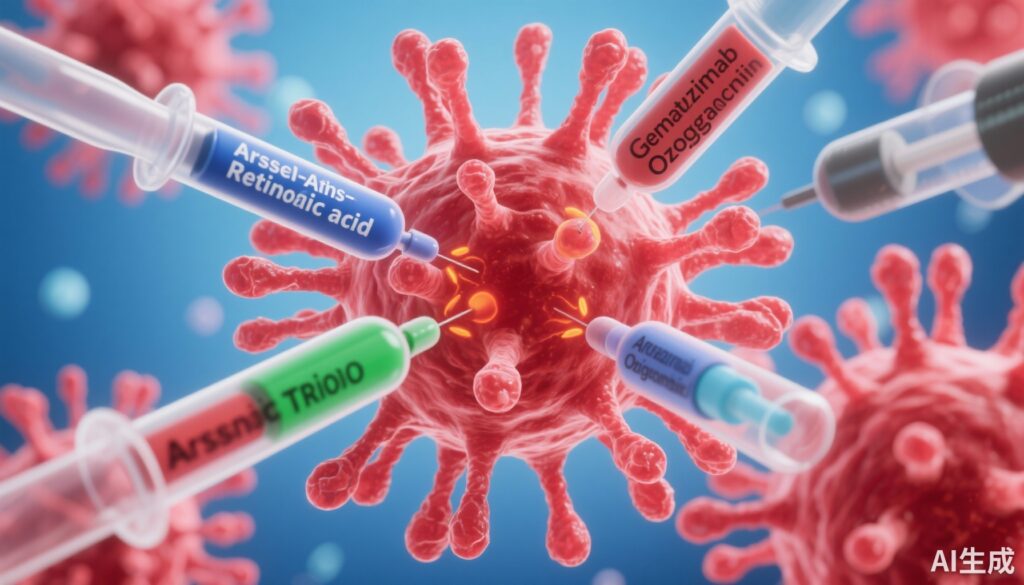Highlight
- The combination of ATO-ATRA with gemtuzumab ozogamicin (GO) achieves a 94% cure rate in both standard- and high-risk acute promyelocytic leukemia (APL) patients.
- Five-year event-free, disease-free, and overall survival rates exceed 92%, with median follow-up of over 5 years.
- The regimen is well tolerated with low induction mortality (2.7%) and no veno-occlusive disease observed.
- Negative measurable residual disease was achieved in over 97% of patients in complete remission, supporting deep molecular responses.
Study Background and Disease Burden
Acute promyelocytic leukemia (APL) is a distinct subtype of acute myeloid leukemia characterized by the PML::RARA fusion gene, resulting in a disrupted differentiation of promyelocytes. Historically, APL had high early mortality due to coagulopathy and differentiation syndrome. However, the introduction of differentiation therapy with all-trans retinoic acid (ATRA) revolutionized treatment, significantly improving outcomes. Subsequent incorporation of arsenic trioxide (ATO) further enhanced survival, particularly in standard-risk APL patients.
Nevertheless, high-risk APL—characterized by elevated leukocyte counts at diagnosis—remains challenging, often requiring more intensive or combination therapies. Gemtuzumab ozogamicin (GO), a CD33-targeted antibody-drug conjugate, has shown promise in AML and is investigated here for its potential to enhance outcomes in high-risk APL with leukocytosis.
Despite existing ATRA-ATO therapy yielding excellent results in standard-risk patients, the long-term efficacy and safety of adding GO in both standard- and high-risk patients, particularly with molecular persistence of disease, required further elucidation. This phase 2 study is a critical step in addressing this gap by providing extended follow-up data on safety, remission durability, and survival.
Study Design
This prospective phase 2 clinical trial enrolled 146 adults with newly diagnosed APL, including 106 (72.6%) standard-risk and 40 (27.4%) high-risk patients. The median age was 53 years (range 19.3–83.9 years), reflecting real-world diversity.
The treatment protocol for induction included daily oral ATRA (45 mg/m2) combined with intravenous ATO (0.15 mg/kg). For high-risk patients and standard-risk patients who developed significant leukocytosis (>10 × 10^9/L), gemtuzumab ozogamicin (GO) was administered at 6–9 mg/m2 to control leukocyte proliferation.
Following induction, consolidation therapy consisted of four courses of ATO-ATRA. GO was reintroduced selectively in patients with persistent measurable residual disease (MRD), specifically those with detectable PML::RARA transcripts, to target residual leukemic clones.
The primary endpoints included rates of complete remission (CR), event-free survival (EFS), disease-free survival (DFS), overall survival (OS), and safety profiles. Molecular remission was monitored through sensitive MRD testing to evaluate depth of response.
Key Findings
The trial reported a robust CR rate of 93.8% (95% CI, 92.2%–98.5%), indicative of effective leukemia clearance during induction. Among these, 97.1% achieved MRD negativity, highlighting profound molecular remission.
At a median follow-up of 61.8 months (approximately 5.2 years, range 4.7 to 128.4 months), crucial long-term outcomes demonstrated remarkable durability:
- The 5-year event-free survival rate was 92.4% (95% CI, 87.9%–97.1%).
- Disease-free survival at 5 years reached 93.6% (95% CI, 89.5%–97.8%).
- Overall survival at 5 years was 93.1% (95% CI, 88.9%–97.7%).
These outcomes underscore sustained remission and survival in a substantial majority of patients.
Induction mortality was relatively low at 2.7%, demonstrating the regimen’s tolerability. Adverse events included elevated liver transaminases occurring in 41.0% and infections in 13.7%, which align with known toxicities of ATO and immunosuppressive therapy. Importantly, no cases of veno-occlusive disease (VOD), a severe vascular complication sometimes linked to GO, were observed, supporting the regimen’s safety profile.
Of note, 68 standard-risk patients (64.2%) received GO due to leukocytosis during treatment, reinforcing the role of GO in mitigating high leukocyte counts outside the high-risk group and possibly preventing leukostasis-driven complications.
Expert Commentary
This long-term follow-up confirms the synergistic benefit of combining differentiation agents ATO and ATRA with targeted immunotherapy GO in APL treatment across risk strata. The study demonstrates that GO addition can facilitate excellent outcomes even in patients with high leukocyte counts and possibly improve molecular eradication in those with residual disease.
Current European LeukemiaNet guidelines endorse ATRA-ATO as frontline therapy in standard-risk APL, with tailored approaches for high-risk patients. This data supports inclusion of GO as a valuable adjunct in high-risk and leukocytosis-prone patients, potentially redefining standard risk stratification and management.
Mechanistically, GO targets CD33, highly expressed on leukemic promyelocytes, delivering a cytotoxic calicheamicin payload, synergizing with differentiation and apoptosis induced by ATO and ATRA. This multi-modal attack likely accounts for the deep and durable remissions observed.
Limitations include the non-randomized phase 2 design and relatively small subgroup numbers, which call for validation in larger, randomized trials. However, the extended median follow-up and detailed safety outcomes strengthen the evidence for incorporating GO in combination regimens.
Conclusion
This phase 2 study establishes that the combination of arsenic trioxide, all-trans retinoic acid, and gemtuzumab ozogamicin delivers sustained, durable remissions with a high cure rate of approximately 94% in patients with both standard- and high-risk acute promyelocytic leukemia. The regimen carries an acceptable safety profile, with low induction mortality, manageable adverse events, and absence of veno-occlusive disease.
Achieving high rates of molecular remission and long-term survival, this combined approach represents a significant advance in APL management, especially for high-risk patients who historically have poorer outcomes. Future randomized controlled trials and long-term real-world data will be essential to confirm these findings and refine patient selection for GO inclusion.
References
Jen WY, Marvin-Peek J, Kantarjian HM, Alvarado Y, Borthakur G, Jabbour E, et al. Long-term follow-up of a phase 2 study of all-trans retinoic acid, arsenic trioxide, and gemtuzumab ozogamicin in acute promyelocytic leukemia. Cancer. 2025 Jan 1;131(1):e35662. doi: 10.1002/cncr.35662. Epub 2024 Nov 25. PMID: 39584789; PMCID: PMC11695139.
Tallman MS, et al. Acute promyelocytic leukemia: evolving therapeutic strategies. Blood. 2022;139(1):38-55.
Lo-Coco F, et al. Retinoic acid and arsenic trioxide for acute promyelocytic leukemia. N Engl J Med. 2013;369(2):111–21.



